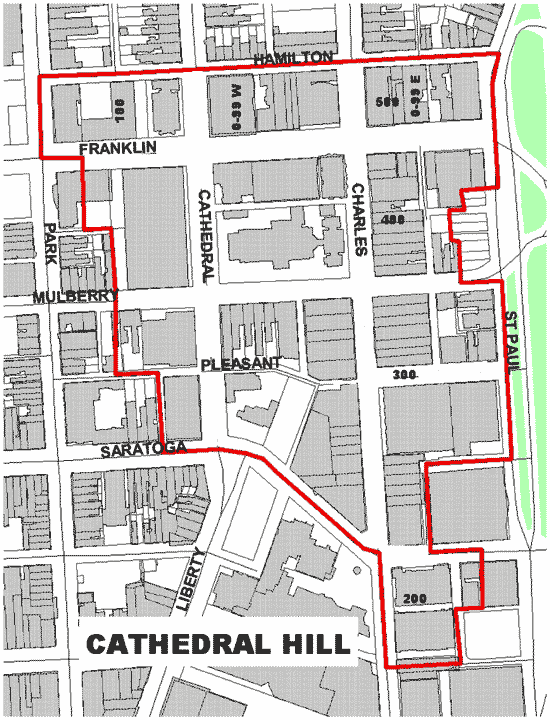Cathedral Hill
National Register of Historic Places 4/27/87
Certified Historic District for Tax Incentives (NR)
Description
 The Cathedral Hill Historic District is an area of mixed commercial, religious and institutional buildings covering approximately 10 blocks in downtown Baltimore. Its general boundaries are Hamilton Street on the north, St. Paul Place on the east, Saratoga Street on the south and Cathedral Street and Park Avenue on the west.
The Cathedral Hill Historic District is an area of mixed commercial, religious and institutional buildings covering approximately 10 blocks in downtown Baltimore. Its general boundaries are Hamilton Street on the north, St. Paul Place on the east, Saratoga Street on the south and Cathedral Street and Park Avenue on the west.
The district has 106 structures, of which 90% contribute to the historic character. The buildings are mostly commercial in use, with the exception of four large churches, dominated by the Catholic Basilica of the Assumption or "the Cathedral", and several large institutional buildings, most of which have been converted to commercial use.
The district originally was mostly rowhouses, which began to be converted to combined residential and commercial use about the middle of the nineteenth century. By the time of the Baltimore Fire of 1904, the district was mostly commercial and the rowhouses had been largely altered by the addition of plate glass display windows and projecting bays. The Fire caused massive relocations of businesses and shops into the district with increasing remodeling of existing buildings and construction of new buildings.
The present building types range in size from two-story commercial structures and converted rowhouses to 14-story office buildings and the inclusive dates of significance are from 1790 to 1940. The stylistic range covers Federal, Greek Revival, the various Renaissance Revival styles of the Victorian period, the Beaux-Arts Classical Revival, and the Art Deco movement. Most have stone or brick facades with metal, wood, and stone detailing. The street plan is basically a grid, except for Saratoga Street along the southern boundary. The integrity of the district remains high in spite of alterations and post-World War II construction.
Significance
The Cathedral Hill Historic District contains several of the most important nineteenth century religious and institutional structures in Baltimore as well as the heart of the early twentieth century retail district. The architectural quality of the district is epitomized by the nationally recognized Basilica of the Assumption (1806 - 1821), designed by Benjamin Latrobe, the First Unitarian Church (1817 - 1818) by Maximilien Godefroy, the Franklin Street Presbyterian Church (New Psalmist Baptist Church) of 1847 by Robert Cary Long, and Old St. Paul's Episcopal Church (1854 - 1856), designed by Richard Upjohn.
The previously established sophistication in architectural design, the "carriage trade" clientele, and the upsurge in building in the aftermath of the 1904 fire in the Baltimore business district produced an almost continuous line of stone and brick facades on Charles Street which led to its being described as the "rue de la Paix" of "Fifth Avenue" of Baltimore. With few intrusions, the Cathedral Hill district retains the character of a unique mixed neighborhood of churches, institutions, and commercial buildings.